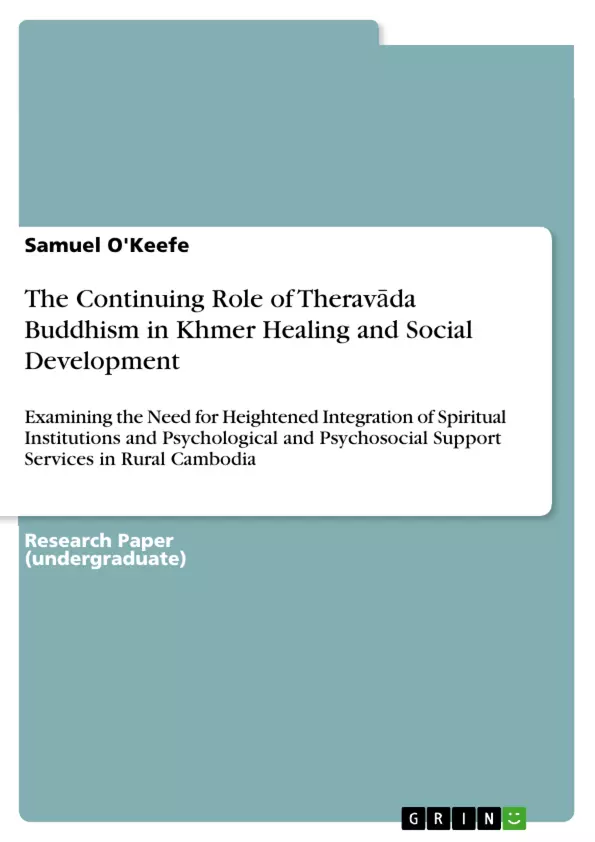This study examines 1) the role that Theravāda Buddhism plays today in Cambodian society and the precise ideals and processes within the philosophy conducive to psychological healing and larger social development, and 2) the cultural competencies upheld by NGOs providing relief from trauma caused by the aforementioned issues, paying specific attention to ways in which these NGOs do and do not harness the healing powers and moral precepts of Theravāda Buddhism.
Research findings suggest the fruitfulness of Buddhist-oriented approaches to psychological healing and social development in a country exhibiting high rates of undiagnosed mental illness and low mental health literacy in the rural provinces, which demonstrate the highest mental health burden. A gradual yet targeted integration of Buddhist spiritual personnel and institutions with psychological and psychosocial support NGOs would be efficacious in enhancing the cultural competency of NGOs’ approaches while also extending the geographic reach of counseling efforts and resources to the most marginalized in the country.
In Cambodia, trauma lingering from the Khmer Rouge era genocide, combined with that produced by compounded social issues including child sexual abuse, human trafficking, and gender-based violence (GBV), contribute to one of highest rates in the world of what a Western diagnostic model would define as PTSD. Such imbricated realities in Cambodia remain stigmatized, taboo, and misunderstood within Khmer society, oftentimes hindering the healing process for survivors at the individual and community levels. NGOs analyzed in this study seek to provide psychological and psychosocial support to those experiencing trauma from these events, and concurrently promote education on these issues.
Considering the predominantly Western origins of national NGO donors, this study is one of the first to examine cultural competence in the context of national NGOs and trauma stemming from contemporary violence in Cambodia. My research examines the impact and sustainability of these organizations’ approaches toward supporting the holistic healing needs of those experiencing trauma or distress, with an eye toward how Theravāda Buddhist principles are incorporated into these support and development methods. Adoption of a Buddhist spiritual lens was informed and encouraged by both primary and secondary research that revealed the healing and social development tools immanent within Buddhist teachings.
Table of Contents
- INTRODUCTION AND OBJECTIVES
- METHODOLOGY
- ETHICAL CONSIDERATIONS
- RESULTS
- Part I: The Compatibility of Buddhism, Healing, and Social Development
- Anatomical Conceptualizations of Trauma and Mental Health in the Khmer Context
- Buddhism as A Healthy, Sustainable Mode of Being
- Healing, Recovery, and Development as Inherent Within Buddhist Tradition
- Unity and Harmony: Healing and Development Within a Collectivist Society
- Buddhism: A Source of Healing and Development in a World of Global Flows?
- Translations of Karma: Perceived Fatalism or a Coping and Development Tool?
- Part II: Buddhism and Spirituality in the NGO Sector: Examining Cultural Competencies
- BUDDHIST-AFFILIATED NGOs
- NON-BUDDHIST-AFFILIATED NGOS
- DISCUSSION
- LIMITATIONS OF NGOS AND RECOMMENDATIONS
- CONCLUSIONS
- RESEARCH LIMITATIONS
- FUTURE RESEARCH
Objectives and Key Themes
This research seeks to investigate the role of Theravada Buddhism in healing and social development in Cambodia, specifically exploring how Buddhist principles can be integrated with psychological and psychosocial support services provided by national NGOs. The study aims to assess the cultural competency of these NGOs in addressing trauma stemming from the Khmer Rouge era and contemporary societal issues, considering the need for a more holistic approach to healing and development.
- The role of Theravada Buddhism in Cambodian society and its relevance to psychological healing and social development.
- The cultural competency of national NGOs in providing psychological and psychosocial support to survivors of trauma.
- The potential for integrating Buddhist principles and practices into NGO interventions.
- The effectiveness of Buddhist-oriented approaches in addressing mental health issues and promoting social development in rural Cambodia.
- The need for collaboration between Buddhist institutions and NGOs to enhance cultural competency and expand the reach of mental health services.
Chapter Summaries
The first part of the research focuses on the compatibility of Buddhism, healing, and social development in the Khmer context. It examines the conceptualization of trauma and mental health within a Buddhist framework and explores the inherent healing and development tools within Buddhist tradition. The chapter also discusses the role of unity and harmony in a collectivist society and how Buddhism can contribute to healing and development in a globalized world. The final chapter in this section analyzes the concept of karma and its potential as a coping mechanism and development tool.
The second part of the research investigates the role of Buddhism and spirituality in the NGO sector, examining the cultural competencies of both Buddhist-affiliated and non-Buddhist-affiliated NGOs. This section delves into the specific approaches and strategies employed by these organizations in providing psychological and psychosocial support to trauma survivors, analyzing their strengths and limitations in integrating Buddhist principles into their work.
Keywords
This research examines the intersection of Buddhism, healing, and social development in rural Cambodia, focusing on the role of national NGOs in providing trauma-informed care. Key themes include Theravada Buddhism, spirituality, cultural competence, trauma, gender-based violence, human trafficking, sexual abuse, psychological/psychosocial support, and the potential for integrating Buddhist principles into mental health interventions.
- Arbeit zitieren
- Samuel O'Keefe (Autor:in), 2018, The Continuing Role of Theravāda Buddhism in Khmer Healing and Social Development, München, GRIN Verlag, https://www.grin.com/document/500337



